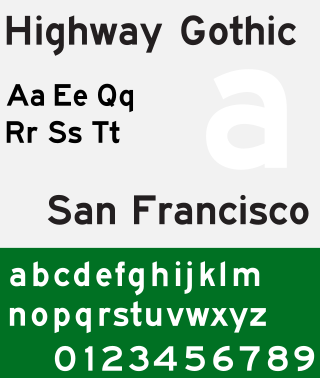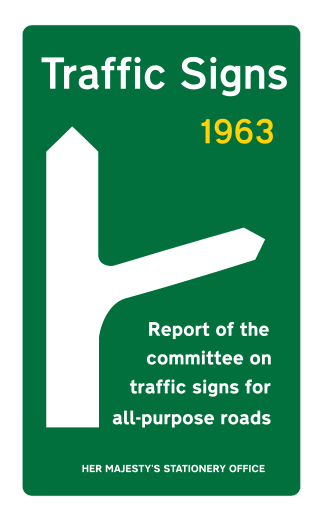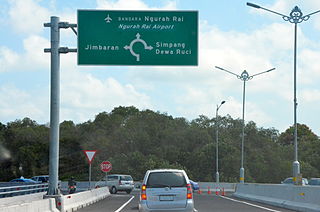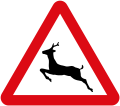
A warning sign is a type of sign which indicates a potential hazard, obstacle, or condition requiring special attention. Some are traffic signs that indicate hazards on roads that may not be readily apparent to a driver.

The Manual on Uniform Traffic Control Devices for Streets and Highways is a document issued by the Federal Highway Administration (FHWA) of the United States Department of Transportation (USDOT) to specify the standards by which traffic signs, road surface markings, and signals are designed, installed, and used. In the United States, all traffic control devices must legally conform to these standards. The manual is used by state and local agencies as well as private construction firms to ensure that the traffic control devices they use conform to the national standard. While some state agencies have developed their own sets of standards, including their own MUTCDs, these must substantially conform to the federal MUTCD.

Road signs in the Republic of Ireland do not differ greatly from those used elsewhere in Europe – with the notable exception that hazard or warning signs follow the "New World" style of a yellow diamond. The symbols used on these warning signs do, nevertheless, resemble much more closely those used in the rest of Europe than many of those seen in the United States.

Road signs in the United Kingdom and in its associated Crown dependencies and overseas territories conform broadly to European design norms, though a number of signs are unique: direction signs omit European route numbers, and road signs generally use the imperial system of units, unlike the rest of Europe. Signs in Wales and parts of Scotland are bilingual.

Clearview, also known as Clearview Hwy, is the name of a humanist sans-serif typeface family for guide signs used on roads in the United States, Canada, Indonesia, the Philippines, Israel, Brazil and Sri Lanka. It was developed by independent researchers with the help of the Texas Transportation Institute and the Pennsylvania Transportation Institute, under the supervision of the Federal Highway Administration (FHWA). It was once expected to replace the FHWA typefaces in many applications, although newer studies of its effectiveness have called its benefits into question.

Highway Gothic is a sans-serif typeface developed by the United States Federal Highway Administration (FHWA) and used for road signage in the Americas, including the U.S., Canada, Latin America and some Caribbean countries, as well as in Asian countries influenced by American signage practices, including the Philippines, China, Taiwan, Malaysia, Indonesia and Thailand.

Road signs in Malaysia are standardised road signs similar to those used in Europe but with certain distinctions. Until the early 1980s, Malaysia closely practice in road sign design, with diamond-shaped warning signs and circular restrictive signs to regulate traffic. Signs usually use the Transport Heavy font on non-tolled roads and highways. Tolled expressways signs use a font specially designed for the Malaysian Highway Authority (LLM) which is LLM Lettering. It has two type of typefaces, LLM Narrow and LLM Normal. Older road signs used the FHWA Series fonts typeface also used in the United States, Canada, and Australia.
Traffic sign design involves any tasks in the process of designing traffic signage. Traffic signs may provide information about the law, warn about dangerous conditions and guide roadway users. Traffic signs vary depending upon their use, using different symbols, colors and shapes for easy identification.

An advisory speed limit is a speed recommendation by a governing body, used when it may be non-obvious to the driver that the safe speed is below the legal speed. It is a posting which either approximates the Basic Speed Law or rule or is based on a maximum g-force exerted at a specific speed. Advisory speed limits are often set in areas with many pedestrians, such as in city centres and outside schools, and on difficult stretches of roads, such as on tight corners or through roadworks. While travelling above the advisory speed limit is not illegal per se, it may be negligence per se and liability for any collisions that occur as a result of traveling above the limit can be placed partially or entirely on the person exceeding the advisory speed limit.

A direction sign, more fully defined as a direction, position, or indication sign by the Vienna Convention on Road Signs and Signals, is any road sign used primarily to give information about the location of either the driver or possible destinations, and are considered a subset of the informative signs group. Direction signs are far more varied internationally than other classes of sign, as the Vienna Convention does not specify sizes, colours, symbols or positions of such signs.

European traffic signs present relevant differences between countries despite an apparent uniformity and standardisation. Most European countries refer to the 1968 Vienna Convention on Road Signs and Signals. The convention has been adopted by the following countries : Albania, Armenia, Austria, Belarus, Belgium, Bosnia and Herzegovina, Bulgaria, Croatia, Cyprus, the Czech Republic, Denmark, Estonia, Finland, France, Georgia, Germany, Greece, Hungary, Italy, Latvia, Liechtenstein, Lithuania, Luxembourg, Moldova, Montenegro, Netherlands, North Macedonia, Norway, Poland, Portugal, Romania, Russia, San Marino, Serbia, Slovakia, Slovenia, Spain, Sweden, Switzerland, Turkey, Ukraine and the United Kingdom. The convention has not been adopted by Ireland, Iceland or Malta.

Road signs in Italy conform to the general pattern of those used in most other European countries, with the notable exception that the background of motorway (autostrada) signs is green and those for 'normal' roads is blue. They are regulated by the Codice della Strada and by the Regolamento di Attuazione del Codice della Strada in conformity with the 1968 Vienna Convention on Road Signs and Signals.

Road signs in Thailand are standardized road signs similar to those used in other nations but much of it resembles road signage systems used in South American countries with certain differences, such as using a blue circle instead of a red-bordered white circle to indicate mandatory actions. Until the early 1980s, Thailand closely followed American, European, Australian, and Japanese practices in road sign design, with diamond-shaped warning signs and circular restrictive signs to regulate traffic. The Department of Railway maintains a standard on the typeface used in the sign, with custom made type for Thai text, unofficially named "Thang Luang" (อักษรทางหลวง) and a small derivation of FHWA Series fonts typeface, which is used on American road signage, for Latin text. In most Bangkok Metropolitan Area's routes, TS Lopburi is still used.

The design of road signs in Poland is regulated by Regulation of the Ministers of Infrastructure and Interior Affairs and Administration on road signs and signals. The Annex 1 to the regulation describes conditions related to usage of the road signs – size, visibility, colors and light reflections, typeface and text, criteria of choosing the type of foil to signs faces, colorful specimens and schematics.

Road signs in Israel are regulated by the Ministry of Transportation in the Division of Transportation Planning, most recently set forth in June 2011.

The Worboys Committee was formed by the British government to review signage on all British roads. In its July 1963 report Traffic signs: report of the committee on traffic signs for all-purpose roads, it found existing road signs to be obsolete for the increasing numbers of motor vehicles and their increasing speeds, and made over a dozen key recommendations. The committee went on to completely revise road signs in Britain, with an emphasis on symbols alone, adopting standard colour and shape practices used in mainland Europe and a new typeface. Its principles were adopted and are still the basis of all road signs in the United Kingdom.

Road signs in Indonesia are standardized road signs similar to those used in other nations but with certain distinctions. As a former Dutch colony, until the 1970s road signs in Indonesia closely followed The Netherlands rules on road signs. Nowadays, Indonesian road sign design are a mix of European, US MUTCD, Australia, New Zealand and Japanese road sign features. According to the 2014 Minister of Transport's Regulation No. 13 concerning Traffic Signs, the official typeface for road signs in Indonesia is Clearview. Indonesia formerly used FHWA Series fonts as the designated typeface though the rules are not being implemented properly.

Terminology related to road transport—the transport of passengers or goods on paved routes between places—is diverse, with variation between dialects of English. There may also be regional differences within a single country, and some terms differ based on the side of the road traffic drives on. This glossary is an alphabetical listing of road transport terms.

Road signs in Cambodia are standardized road signs are similar to those used in Europe but much of it resembles road signage systems used in South American countries with certain differences. The designs of road signage match their neighbours of Thailand and Malaysia, both of which adopt a modified version of the South American road signage system. Until the early 1980s, Cambodia closely followed American, European, Australian, and Japanese practices in road sign design, with diamond-shaped warning signs and circular restrictive signs to regulate traffic. Unlike Thailand and Malaysia, Cambodia does not use the FHWA Series fonts typeface, favouring Helvetica instead.
This article is a summary of traffic signs used in each country.












































